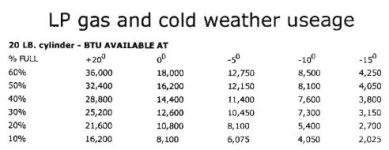ReluctantTraveler
Well-known member
Our entry-level travel trailer is 3-season, but we sometimes find ourselves winter camping in it.
I've rerouted the entire water system inside the rig, and all of the external tanks and waste valves have 12v heating pads on them that I can turn on in freezing temperatures.
The one thing I'm curious about: should I drop $180 on a propane tank heater blanket?
We have two 20 lbs tanks currently. This week, we camped in NH and it dropped down to 9 degrees at night. The tanks were brand new and full, so we had no issues, but I've heard stories about them not being able to vaporize from liquid to gas fast enough as the temperature drops (I know the freezing temp is absurdly low for propane, that's not the issue).
Is this a real concern? Is it worth investing in the heater? We have an inverter and a relatively large LiFePo4 batter bank, so power isn't the main concern here. Or is this just a "buy more gear" gimmick that I can skip?
I've rerouted the entire water system inside the rig, and all of the external tanks and waste valves have 12v heating pads on them that I can turn on in freezing temperatures.
The one thing I'm curious about: should I drop $180 on a propane tank heater blanket?
We have two 20 lbs tanks currently. This week, we camped in NH and it dropped down to 9 degrees at night. The tanks were brand new and full, so we had no issues, but I've heard stories about them not being able to vaporize from liquid to gas fast enough as the temperature drops (I know the freezing temp is absurdly low for propane, that's not the issue).
Is this a real concern? Is it worth investing in the heater? We have an inverter and a relatively large LiFePo4 batter bank, so power isn't the main concern here. Or is this just a "buy more gear" gimmick that I can skip?

